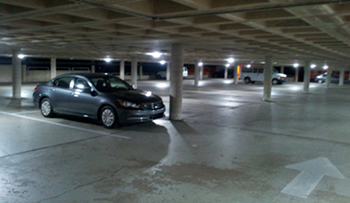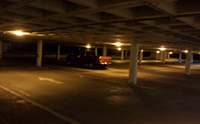Campus makes green changes
Campus makes green changes
Tri-Level Parking Garage Lighting Project
- Replacement of 65 fixtures located on the lower two parking decks and two stairwells
- Annual operating hours = 8760
- Old fixtures were 290 Watt Metal Halide with annual use =165,126 kwh/yr ($13,210)
- New fixtures are 52 watt LED with estimated annual use = 29,809 kwh/yr ($2,385)
- Total estimated annual energy savings = 135,317 kwh/yr ($10,825/yr)
- Total cost of new fixtures ($285 each) = $18,525
- Labor accomplished by in-house maintenance staff
- Payback (excluding labor costs) = $18,525/ $10,825 = 1.71 years
Energy and financial savings are the goal of campus upgrades completed as part of Bloomsburg University’s facilities management department’s energy reduction plan.
“We are working to implement Energy Conservation Measures (ECMs) with short paybacks and large energy savings so we can start showing movement toward the goal,” says John Holtzman, assistant director of energy and environmental. The plan aims to reduce energy consumption by 20 percent.
One ECM now underway is the installation of energy-efficient LED lighting in the lower parking area and stairwells of the tri-level garage next to Elwell Residence Hall. BU facilities staff will install LED lighting fixtures purchased through a sustainability account initially funded by energy rebates from PP&L Electric. This project will pay for itself in 18 months. The same type of LED lighting was installed by BU facilities staff in areas within Redman Stadium.
Another completed ECM is the installation of motion sensors in the hallways and stairwells of Hartline Science Center.
“There are hours a day that there’s no one in there,” says Holtzman, describing how installing the motion sensors has dimmed lighting from 100 percent to 80 percent while in use and further dims or turns off lighting in hallways and stairwells to safe levels after 15 minutes of non-occupancy. The motion sensors will save the energy from being wasted when classes are not meeting in the building.
Hartline was used as a test for similar projects, and motion sensors have been purchased for installation in the stairwells and halls of the Jessica Kozloff Apartments on Upper Campus and Elwell Residence Hall, he adds.
Much of the funding for these ECMs comes from rebates awarded thanks to the Act 129 energy rebate program, Pennsylvania’s energy efficiency and conservation law; grants; and a BU sustainability fund, support annually through utility account savings.
“If there’s a funding opportunity open, we go after it, and we’ve had some success,” says Holtzman. One such grant came in 2009 from the Pennsylvania Conservation Works! Grant Program, funded by the Department of Energy’s Energy Efficiency Block Grant Program. The $250,000 grant was used in part to replace the two existing chillers at Carver Hall and Scranton Commons with a singular magnetic compressor chiller to reduce annual energy use by 51 percent, saving BU more than $12,000 per year.
Holtzman says more ECMs are in the planning stages. One initiative would automatically shut down faculty and staff workstations from a central location during an established timeframe. Others involve installing more energy-efficient lighting and plumbing.
Holtzman says students, faculty and staff can play a part in energy conservation. Simple measures students can take to conserve include turning off faucets when brushing teeth or shaving, reporting leaks as soon as they are discovered and turning off lights, computers, printers, copiers and other electric appliances when not in use. #BUSustainability
— Nick Cellucci ’16


